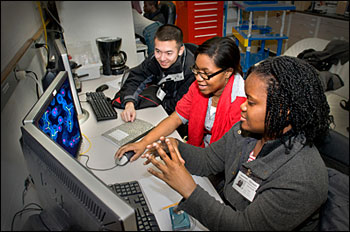Mini-Course Brings Research Reality to New York Students
February 8, 2010

CSTEP Mini-course students learn about 3-D protein imaging technology at the NSLS. They are, from left, Kimchung Pang, Long Island University Brooklyn; Kimberly Hilaire, Long Island University Brooklyn; and Jennel Vincent, Medgar Evers College.
Brookhaven scientists captured the imagination of New York State college students with the latest research technology during the College Science & Technology Entry Program (CSTEP) Mini-course. The annual workshop, held January 11-15, is a collaborative effort with the New York State Education Department’s CSTEP Program, which provides economically disadvantaged and minority undergraduates with advancement opportunities in the science, technology, engineering and math (STEM) fields.
“The Mini-course is often the first opportunity that our students have to see science research in action,” said Nina Leonhardt, the associate dean for continuing education at Suffolk Community College. “It is often the one experience that piques their interest in research and motivates them to continue in the sciences.”
While learning about Brookhaven’s research, the 24 Mini-course participants also gained the hands-on experience they need to apply for summer research programs, such as the Department of Energy’s Community College Institute (CCI) or the Science Undergraduate Laboratory Internship (SULI).
This year’s workshop focused on structural biology, but highlighted all BNL research opportunities with lectures about physics, nanomaterials, computational sciences, plant biology and addiction. Students also toured the National Synchrotron Light Source (NSLS), the Center for Nanomaterials (CFN), New York Blue, and the Relativistic Heavy Ion Collider (RHIC).
“The students were able to make the connection between how these large facilities can play a role with small, benchtop science,” said Scott Bronson, a BNL educational programs administrator. “And they learned how a national lab can act as a core facility for surrounding universities’ research.”
By using proteins as the focus for the hands-on activities, students were able to explore many levels of science -- from basic bench work to advanced 3-D computer imaging technology. Topics covered included protein expression, isolation and crystallization.
BNL researchers Alex Soares, Annie Heroux and Deborah Stoner-Ma taught students how to solve the crystal structure of isolated proteins using X-ray crystallography data at the NSLS - the same light diffraction technique used by former BNL researcher Venkatraman Ramakrishnan for his Nobel Prize-winning work with ribosomal structures- a cellular complex necessary for making proteins. The advanced 3-D imaging software used to visualize and model the proteins captivated students.
“Our generation loves technology,” said Carolyn Sealy, a junior biology major at Medgar Evers College. “The 3-D imaging was like something from a crime solving TV show.”
Perhaps students weren’t solving crimes, but they did learn how to unravel the mysteries surrounding protein structure and, more importantly, discovered the real research opportunities available at Brookhaven, should they decide to embark upon their own scientific careers.
2010-1579 | INT/EXT | Newsroom









